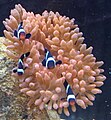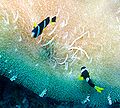Amphiprioninae
Amphiprioninae is a subfamily of marine fish of the Pomacentridae family, which includes only the genera Amphiprion and Premnas, whose components are known such as clown fish or anemone fish.
Clownfish are characterized by their contrasting and intense colors, red, pink, black, yellow, orange or white. They come from the coral reefs of the Indo-Pacific, and live together with anemones, theoretically predatory species, from which they obtain protection against possible attackers. In exchange, the clownfish offer the possibility of bringing food closer to the anemone's mouth, and, with their continuous movement, they clean the oral disc and the tentacles of the anemone, avoiding bacterial infections. In time, the adults defend their host anemones from specialized predatory fish, such as butterflyfish of the family Chaetodontidae.
Easy to obtain, they are easy-maintenance fish, which is why all their varieties are a good option for aquariums. These are carnivorous species, which need a vegetable contribution in their diet. In their natural environment, clownfish chase their small prey.
Species
The World Register of Marine Species accepts the following species in the two genera of the subfamily:
- Gender Amphiprion. (Bloch & Schneider, 1801):
- Amphiprion akallopisos. (Bleeker, 1853)
- Amphiprion akindynos. (Allen, 1972)
- Amphiprion allardi. (Klausewitz, 1970)
- Amphiprion barberi. (Allen, Drew & Kaufman, 2008)
- Amphiprion bicinctus. (Rüppell, 1830)
- Amphiprion chagosensis. (Allen, 1972)
- Amphiprion chrysogaster. (Cigure 1830)
- Amphiprion chrysopterus. (Cigure 1830)
- Amphiprion clarkii. (Bennett, 1830)
- Amphiprion ephippium. (Bloch, 1790)
- Amphiprion frenatus. (Brevoort, 1856)
- Amphiprion fuscocaudatus . (Allen, 1972)
- Amphiprion latezonatus . (Waite, 1900)
- Amphiprion latifasciatus . (Allen, 1972)
- Amphiprion leucokranos . (Allen, 1973)
- Amphiprion mccullochi . (Whitley, 1929)
- Amphiprion melanopus. (Bleeker, 1852)
- Amphiprion nigripes. (Regan, 1908)
- Amphiprion ocellaris. (Cigure 1830)
- Amphiprion omanensis . (Allen & Mee, 1991)
- Amphiprion pacificus . (Allen, Drew & Fenner, 2010)
- Amphiprion percula. (Lacepède, 1802)
- Amphiprion perideraion. (Bleeker, 1855)
- Amphiprion polymnus. (Linnaeus, 1758)
- Amphiprion headingcinctus. (Richardson, 1842)
- Amphiprion sandaracinos. (Allen, 1972)
- Amphiprion sebae. (Bleeker, 1853)
- Amphiprion thiellei . (Burgess, 1981)
- Amphiprion tricinctus. (Schultz & Welander, 1953)
- Gender Premnas. (Cigure 1816):
- Premnas biaculeatus. (Bloch, 1790)
Morphology
The coloration of the body is varied, depending on the species, and the base color of the body can be bright orange, or reddish-brown, or yellow, or black, or pink-brown. These colors can be traversed with one, two or three stripes, depending on the species, which cross the body vertically, dividing it into portions. These bands are usually delimited with narrow black margins, and are usually white, although in some species, such as Amphiprion chrysopterus, they are bluish. There are also some species, such as the Amphiprion perideraion, which have a white line running along its upper part, from the head to the caudal fin, and only a narrow vertical stripe, between the head and the pectoral fins. The Amphiprion sandaracinos also has the horizontal white line on its back, but it differs from A. perideraion in that the line begins on the upper lip, and not between the eyes, in that it does not have the vertical stripe of the former, and in that its base color is orange, being in A. perideraion pinkish-orange. A black, rather than orange, banded white Amphiprion ocellaris occurs off northern Australia.
They have a rounded caudal fin and can grow up to 80 or 160 mm in length, depending on the species. Females are larger than males in this subfamily.(Nelson, Phang, & Chou, 1996).
Superficial mucosa
All fish in the subfamily have a mucous membrane covering their scales. The mucus usually contains high amounts of lipids and glycoproteins, however in the Amphiprioninae subfamily they have a special adaptation in the mucous layer, being much thicker and thicker. Unlike other fish species, the protective shell of the species of the genus Amphiprion lacks a specific substance that triggers the attack of nematocysts (anemone stings), allowing immunity against toxic fish bites. Little is known about mucus, except that its secretion is due to genetic factors, and the nature of its composition is passed down through the generations in each species. In other families of fish, the mucus is used as protection against harmful bacteria, an osmotic regulator, and also helps the fish in nest making. The difference in mucus has led to the divergent trajectory of fish from anemones and other species. This mucous layer makes it immune to the sting of anemones, which feed mainly on fish. Before settling among the tentacles of these sedentary marine animals, the clownfish performs a dance.
Ecology
They are found on the coasts, in coral reefs, usually not very deep, between 1 and 60 meters deep, usually between 3 and 15 meters. They usually inhabit in crevices of rocky or limestone substrate reefs.
Distribution
They are distributed in tropical waters of the Indo-Pacific Ocean, from the East African coast, Red Sea, Madagascar, Gulf of Oman, Gulf of Bengal, Seychelles, Maldives, India, Sri Lanka, Indonesia, China, Vietnam, Philippines, Japan, New Guinea, Australia, Fiji, and central Pacific islands to Hawaii, Micronesia, and Polynesia.
Mutualism
They are usually found in mutualistic association with anemones. Depending on the species of clownfish, it is associated with certain species of anemones. In the case of A. ocellaris, for example, mainly to the anemones Heteractis magnifica, Stichodactyla gigantea and Stichodactyla mertensii. Anemones possess nematocysts on the surface of their tentacles, and are capable of injecting a paralyzing toxin, which they use to trap and kill their prey (including fish). Clownfish are not immune to the toxin from birth, but they slowly become immunized with the help of a layer of mucus they secrete onto their skin, making it difficult for nematocysts to attach, allowing their bodies to absorb small doses at which Gradually, the fish gets used to it, becoming completely immune to the toxin when it is an adult.
An immunized clownfish can move freely among the anemone's tentacles, allowing it to use the anemone as a microhabitat, where it finds food, shelter, and protection from larger fish. At the same time, the fish feeds on the particles left over from the anemone's diet, as well as parasites and other organisms that could affect it.
Occasionally, they are found sharing anemones in harmony with shrimp of the genus Periclimenes.
Examples of host anemone species:
Food
They feed on plants (34%), benthic invertebrates (44%), and zooplankton. Planktonic foods such as zooplankton, copepods, and algae are the primary food source for the subfamily (Myers 1999). They are classified as generalist omnivores, since they feed on the same amount of algae as on animals (Sano et al. 1984). They have also been known to consume the parasites of their host anemones (Thresher 1984).
Feeding is also dominated by the hierarchical structure of group dynamics in the anemone. Because smaller fish receive the most aggression from others, they are forced to reduce the energy invested in feeding at great distances from the anemone and tend to stay close, where interspecific competition is greatest. Also, it is not safe for smaller fish to stray too far from the safety of the anemone (Fautin and Allen 1992). The dominant fish forages at greater distances, but generally no further than several meters from the anemone.
Playback
They are oviparous by external fertilization. They are also protandrous hermaphrodites, this means that all the fry are males, and that they have the ability to become females, when the hierarchical situation in the group allows it, with the largest specimen of the clan becoming the dominant female, since They are organized in matriarchies. Her gender is somewhat easy to identify, since the female is theoretically the largest in the clan. When she dies, the small dominant male becomes a female. In any case, they are monogamous.
Reproduction occurs as soon as the water temperature begins to rise, although, since they inhabit tropical waters, they can reproduce almost all year round. The male prepares the laying site, waits for the female to lay the eggs there, and fertilizes them. Subsequently, he flaps his fins periodically to oxygenate the eggs, and eliminates those that are in poor condition.
Gallery
Bibliographic sources
- Newcomb, D. and W. Fink. 2004. "Amphiprion ocellaris" (On-line), Animal Diversity Web. Accessed on May 11, 2010 at http://animaldiversity.ummz.umich.edu/site/accounts/information/Amphiprion_ocellaris.html.
- Arvedlund, M., L. Nielsen. 1996. Do the anemonefish Amphiprion ocellaris (Pisces: Pomacentridae) imprint themselves to their host sea anemone Heteractis magnifica (Athozoa: Actinidae)?. Ethology, 102: 197-211.
- Arvedlund, M., I. Bundgaard, L. Nielsen. 2000. Host imprinting in anemonefishes (Pisces: Pomacentridae): does it dictate spawning site preferences?. Environmental Biology of Fishes, 58: 203-213.
- Bhat, A. 2004. Coral reefs and their fauna: An underwater fantasyland. Resonance, September: 62-73.
- Fautin, D., G. Allen. 1992. Field Guide to Anemonefishes and their Host Sea Anemones. Perth: Western Australian Museum.
- FishBase, Amphiprion ocellaris (On-line)
- Fricke, H., S. Fricke. 1977. Monogamy and sex change by aggressive dominance in coral reef fish. Nature, 266: 830-832.
- IUCN, 2003. "2003 IUCN Red List of Threatened Species" (On-line). Accessed on October 22, 2004 at www.iucnredlist.org.
- MarineBio, 1998. "False Clownfish" (On-line). Accessed October 21, 2004 at https://web.archive.org/web/20071023004200/http://www.marinebio.com/species.asp?id=29.
- Myrberg, Jr., A., L. Fueman. 2002. The Sensory World of Coral Reef Fishes. Pp. 146 in P. Sale, ed. Coral Reef Fishes. San Diego, California: Academic Press.
- Nelson, J., P. Phang, L. Chou. 1996. Survival and growth rates of the anemonefish Amphiprion ocellaris: a transfer experiment. Journal of Fish Biology, 48: 1130-1138.
- Sadovy, Y., A. Vincent. 2002. Ecological Issue and the Trade in Live Reef Fishes. Pp. 395 in P. Sale, ed. Coral Reef Fishes. San Diego, California: Academic Press.
- Sano, M., M. Shimizu, Y. Nose. 1984. Food habits of teleostean reef fishes in Okinawa Island, Southern Japan. Japan: University of Tokyo Press.
- Thresher, R. 1984. Reproduction in Reef Fishes. New Jersey: T.F.H. Publications, Inc. 2010/05/09 01:36:55.921 GMT-4.
































